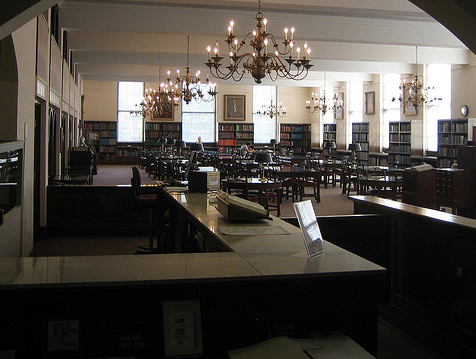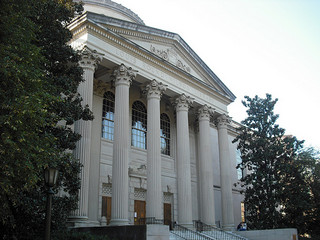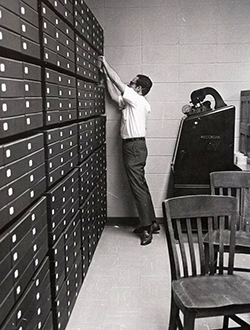
Important collections of North Carolina historical documents, books, photographs, and other materials are maintained at many libraries throughout the state. The North Carolina Collection, a department of the library of the University of North Carolina at Chapel Hill, is the largest and most comprehensive repository of published materials relating to any single state. Its origins date to 1844 when David L. Swain, then president of the university, founded the Historical Society of the University of North Carolina. Following Swain's death during Reconstruction, parts of his collection were removed from the university, but the surviving materials were safeguarded by Kemp P. Battle and then by Louis Round Wilson, who became university librarian in 1901. Wilson established the North Carolina Collection as a department within the library, and with funds provided by John Sprunt Hill hired Mary Lindsay Thornton as its first full-time librarian in 1917. William S. Powell succeeded Thornton in 1958, and upon Powell's transfer to the UNC Department of History in 1974, H. G. Jones became curator. Jones retired in 1994, and Robert G. Anthony Jr. assumed the post.
The university's purchase of historian Stephen Beauregard Weeks's library in 1918 approximately doubled the size of the book holdings. History professor Joseph G. deRoulhac Hamilton was so successful in bringing in manuscripts from North Carolina and neighboring states that, in 1930, most of the manuscript materials were transferred from the North Carolina Collection to the newly established Southern Historical Collection at UNC. While not exclusively focused on North Carolina, the Southern Historical Collection began to collect a vast amount of materials relating to the state. Thereafter, except for the Thomas Wolfe Collection and a few other special groups of manuscripts, the North Carolina Collection concentrated on books, pamphlets, periodicals, broadsides, maps, microforms, and university theses and dissertations.

The beneficence of John Sprunt Hill, who earmarked profits from the Carolina Inn and a block of business buildings in downtown Chapel Hill for the support of the collection, as well as endowments established by North Carolinians Bruce Cotten and Archie K. Davis, among others, have continued to supplement library funds. The extra funds allow the North Carolina Collection to continue its policy of acquiring one or more copies of all publications by North Carolinians regardless of subject and language and about North Carolina or North Carolinians regardless of author or language. When the collection commemorated its sesquicentennial in 1994, its cataloged holdings numbered 120,839 books, 78,051 pamphlets, 4,258 broadsides, 4,545 maps, 17,760 microforms, and thousands of other items. The collection's staff identifies, orders, catalogs, maintains, and provides reference services to its impressive holdings. Because the collection is a statewide resource for the benefit of North Carolina citizens, its reading room is open seven days a week, though closed on state holidays.
The North Carolina Collection began the formal development of a photographic archive in 1929. In the early 2000s the collection's photographic holdings totaled more than 400,000 images of North Carolina's people, places, and events, maintaining files for all 100 of the state's counties. During the renovation of Wilson Library in the 1980s, the collection's reading room moved to the west wing and the library converted its former space in the east wing into the North Carolina Collection Gallery. The gallery displays many rare examples of North Caroliniana along with artwork and museum items acquired by the collection over the years.
Unique collections of North Carolina historical materials exist at practically every university library within the University of North Carolina system as well as at libraries of the state's private universities. These include collections of oral histories, music, books, legal documents, wills, and other primary artifacts and materials. The Verona Joyner Langford North Carolina Collection at East Carolina University originated in 1909, when the university's library began to collect materials related to the state's history. In 1962 Mrs. Frankie Cubbedge was hired to oversee the collection, which had grown to require a new library addition and a reading room. In 2000, after further expansion under Marguerite Wiggins, librarian from 1968 to 1991, the collection was renamed for benefactor Verona Joyner Langford. The collection, one of the largest in the state, is the best collection of materials relating to North Carolina's eastern region.

The Southern Historical Collection at UNC-Chapel Hill has continued to expand in both size and service. In the early 1980s, the administrative unit's name changed to the Manuscripts Department, with holdings organized in three separate components: the Southern Historical Collection, the University Archives, and General and Literary Manuscripts. In 1985 the department added the Southern Folklife Collection, established to document the region's expressive traditions, especially in music and folklore. By the early 2000s the Manuscripts Department had grown to more than 20 million manuscripts, 86,000 still images, and 124,000 audio and moving-image recordings.
The Southern Historical Collection continues to acquire eighteenth- and nineteenth-century manuscripts, along with substantial collections of twentieth-century materials. The collection includes documents of people who spent their entire lives in small North Carolina communities and oral history interviews with textile workers and bank presidents. Some collections, such as those of the Cameron family of North Carolina and the senatorial files of Sam J. Ervin Jr., are very large, while others consist of a few letters or a brief diary. Other subject strengths include southern literature, journalism, business history, legal history, and African American life.
There are notable local and regional North Carolina historical collections at many public libraries throughout the state. Some of them, including those in Asheville, Charlotte, Greensboro, New Bern, Salisbury, and Wilmington, have been in existence for many years, are well-maintained, and offer access to historical documents not found elsewhere.